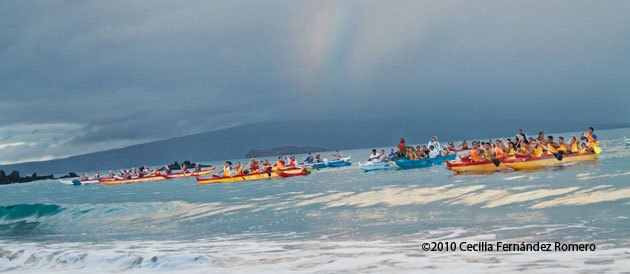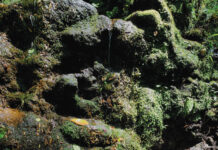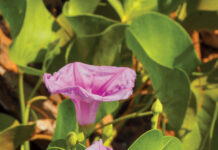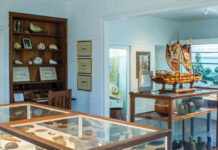Story by Rita Goldman | Photography by Cecilia Fernández Romero
 At five in the morning, Cecilia Fernández Romero and I follow a dimly lit path to the beach below the Grand Wailea Resort, she with camera in hand, me with notepad and pen. The heavy thump and whoosh of surf dominates the predawn darkness.
At five in the morning, Cecilia Fernández Romero and I follow a dimly lit path to the beach below the Grand Wailea Resort, she with camera in hand, me with notepad and pen. The heavy thump and whoosh of surf dominates the predawn darkness.
Later today, the hotel will hum with convention workshops presented by the Hawaiian Chamber of Commerce. We’ve come, hours early, at the invitation of cultural expert Keli‘i Tau‘a, to witness the ceremonial arrival of twenty-four canoes, two for each of the twelve ancient moku, or districts, of Maui.
Slowly, the sky lightens, silhouetting the islands of Kaho‘olawe and Lana‘i. As other figures arrive, some dressed in hula attire, or in traditional capes and lei, we’re met with a striking juxtaposition, as though, here on Wailea Beach, we straddle two different millennia. Behind us rises an opulent resort, the twenty-first century. Before us lies the primordial ocean.
Shortly after six, as participants on shore chant and dance to the rhythm of drums, a line of outrigger and double-hulled canoes rounds the southern point. Soon twenty-four canoes are poised along the horizon, facing the shore, their fiberglass hulls—yellow, red, blue, green—a string of colored beads against the somber backdrop of Kaho‘olawe.
As the sonorous note of a solitary conch moves over the water, a fragment of rainbow appears in the cloud above that island. Aboard the canoes, other conch shells answer, then the paddlers begin to stroke toward shore. The rainbow above them expands, and lingers until the crews have pulled the last of the canoes onto the sand.
One after another, two paddlers present a traditional, bombastic chant and dance to the greeters on shore. “It’s called ha‘a,” Keli‘i Tau‘a tells us later. “Those two young men arrived in the same double-hulled canoe, along with a kupuna wahine [older woman] and a young boy. They told me that when they were rounding the point, a giant sea turtle lifted its head and expelled a great breath, ha, to the woman. A moment later, a young honu surfaced near the child, on the opposite side of the canoe, and blew its breath to him. Ha.”





